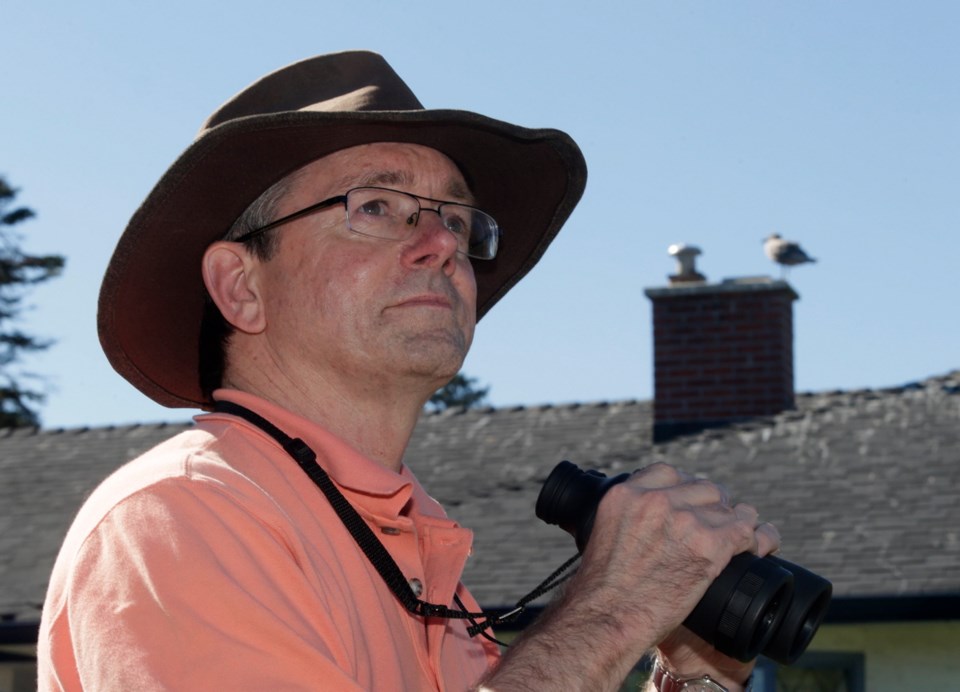You don’t have to be a birdwatcher to worry that welcome species are on the wane around Victoria while so-called nuisance birds are on the rise.
Crap-happy Canada geese have skyrocketed from 125 in the 1970s to more than 6,000 — topping the latest Victoria Christmas Bird Count — and large northwestern fish crows are settling in to city life — loudly.
But western grebes, barn and bank swallows, skylarks, Rufous hummingbirds and even seagulls are in decline.
Avian experts point to habitat destruction and pesticides both here and in South American breeding grounds, along with climate change, the resurgence of predatory species and outside cats.
“We are on a really dangerous slope,” said Ann Nightingale, regional co-ordinator of the B.C. Breeding Bird Atlas. Even the trend to large windows and glass balconies is a fatal issue for robins who have “a strong tendency” to fly straight into them, she said.
In the last 40 years, coastal B.C. suffered a 35 per cent drop in bird populations, compared with 12 per cent nationally, said a 2012 report, The State of Canada’s Birds.
Budgets for bird study are significantly down, said independent biologist Rick Page, who has studied birds for 40 years, including 20 years with the province.
“No one does basic biology anymore — we used to call it fieldwork. It used to be the government — provincial and federal — and university staff.”
It’s not all bad news. Cooper’s hawks are back big-time in urban areas. The purple martin, down to five breeding pairs in B.C. in 1985, is nearing historic highs of 800 pairs thanks to a nest-box program started by the Victoria Natural History Society.
Less agreeable are the ascendant crows.
“The populations are going up and as they become more used to people, they become more of a nuisance because they’re getting into places like backyards,” Page said.
These are wild animals that really should fear people but don’t. Moreover, homeowners are more aware they can’t just remove nests that are bothersome, he said. “In the past … there’s a good chance they would have gone up there and destroyed the nest and broken the eggs on their own, which technically has always been illegal.”
The Capital Regional District, well aware of damage done by Canada geese, estimated at $300,000 by the Peninsula Agricultural Commission, is developing a management strategy.
Control methods discussed on the CRD website range from harassment by herding dogs to egg-addling training for the public. Farmers seem to think that they’re not allowed to kill geese, the website noted.
“Very few requests are received for kill permits, and of those granted, fewer still are executed.”
Decline in marine bird species a mystery, expert says
Local ornithologist James Clowater no longer takes students on field trips to Ogden Point. There’s been too much decline in the marine bird species they can watch there, including loons, red-necked and horned grebes, cormorants and alcids — “a group of seabirds that fly underwater,” he said.
An expert on the western grebe, Clowater also noted this species’ flock from Mill Bay to Patricia Bay was down to 400 a year or two ago from 3,200 in 1994.
Nobody knows the cause of the decline, Clowater said. In the absence of research funds, it’s difficult to tease out whether a problem on the western grebe’s Prairie breeding grounds is to blame, or if they’ve left Mill Bay behind for some other reason.
Much of the tracking of local birds is done by trained and dedicated amateurs, who deserve thanks in the absence of fieldwork funding and political will to invest in birds, he said.
“It does come down to you and I getting out and seeing what’s going on here,” he said. “The Victoria Natural History Society has all kinds of people who are out every day monitoring bird population.”
A lot of what’s going on with birds is not good.
Local barn and bank swallows spend winters in South America where it’s suspected they’re being poisoned by pesticides no longer legal in North America, said independent biologist Rick Page, who has studied birds for 40 years and is a member of the Committee on the Status of Endangered Wildlife in Canada that advises the federal environment minister.
Barn swallows that commonly flew through local fields at break-neck speed to capture insects are now on the threatened list as mosquitoes are increasingly eradicated by local gardeners, said Ann Nightingale, co-president of the Rocky Point Bird Observatory. Climate change causes other insects to hatch early, depriving swallows of their expected food supply.
The skylark colony disappeared from University of Victoria fields with campus construction and they’re “barely hanging in” at the airport, where the perimeter was recently mowed. She’s not sure how that affects ground-level nests but noted that airports are not keen on birds for safety reasons. Since skylarks are an introduced species, no one will do anything officially to protect their habitat, she said.
Even the once-inescapable seagulls are down to about 4,200 gulls sighted in the 2010s from 13,545 in the 1990s, according to the Victoria Christmas Bird Count.
One reason is resurgent bald eagles — up to 20 pairs — who raid the gull nesting grounds off Oak Bay. Eagles also drove the heron colony out of Beacon Hill Park, although some have returned, Nightingale said.
While Anna’s hummingbirds have moved north, to the delight of local bird lovers who leave feeders out in winter, Rufous hummingbirds are down 70 per cent over the past 40 years due to habitat loss, she said.
There are more than 370 bird species on southern Vancouver Island, with regulars making up about 280 to 300. About 190 species can be seen every year, Nightingale said.
“More people are putting out feeders but an awful lot of birds will never come to a feeder.”



